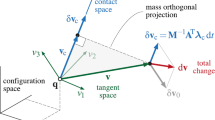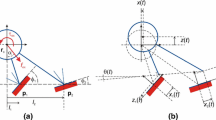Abstract
We investigate the dynamics of finite degree-of-freedom, planar mechanical systems with multiple sliding, unilateral frictional point contacts. A complete classification of systems with 2 sliding contacts is given. The contact-mode-based approach of rigid body mechanics is combined with linear stability analysis using a compliant contact model to determine the feasibility and the stability of every possible contact mode in each class. Special forms of non-stationary contact dynamics including “impact without collision” and “reverse chattering” are also investigated. Many types of solution inconsistency and indeterminacy are identified and new phenomena related to Painlevé’s non-existence and non-uniqueness paradoxes are discovered. Among other results, we show that the non-existence paradox is not fully resolvable by considering impulsive contact forces. These findings contribute to a growing body of evidence that rigid body mechanics cannot be developed into a complete and self-consistent theory in the presence of contacts and friction.





Similar content being viewed by others
References
Anh, L.X.: Dynamics of Mechanical Systems with Coulomb Friction (Foundations of Engineering Mechanics). Springer, New York (2003)
Champneys, A.R., Várkonyi, P.L.: The Painlevé paradox in contact mechanics. J. Appl. Math. (2016). arXiv:1601.03545
Chatterjee, A., Ruina, A.: A new algebraic rigid-body collision law based on impulse space considerations. J. Appl. Mech. 65, 939–951 (1998)
Cottle, R.W., Pang, J.S., Stone, R.E.: The Linear Complementarity Problem: Computer Science and Scientific Computing. Academic Press, Boston (1992)
Dupont, P.E., Yamajako, S.P.: Stability of frictional contact in constrained rigid body dynamics. IEEE Trans. Robot. Autom. 13, 230–236 (1997)
Génot, F., Brogliato, B.: New results on Painlevé paradoxes. Eur. J. Mech. A: Solids 18, 653–677 (1999)
Grigoryan, S.S.: The solution to the Painleve paradox for dry friction. Dokl. Phys. 46, 499–503 (2001)
Hervé, B., Sinou, J.J., Mahé, H., Jezequel, L.: Analysis of squeal noise and mode coupling instabilities including damping and gyroscopic effects. Eur. J. Mech.-A/Solids 27, 141–160 (2008)
Hoffmann, N., Fischer, M., Allgaier, R., Gaul, L.: A minimal model for studying properties of the mode-coupling type instability in friction induced oscillations. Mech. Res. Commun. 29, 197–205 (2002)
Hultén, J.: Brake squeal: a self-exciting mechanism with constant friction. In: Proceedings of the SAE Truck and Bus Metting, 932965, Detroit (1993)
Ivanov, A.P.: Singularities in the dynamics of systems with non-ideal constraints. J. Appl. Math. Mech. 67, 185–192 (2003)
Jellett, J.H.: A Treatise on the Theory of Friction. Hodges, Foster, and Co, Dublin (1872)
Lecornu, L.: Sur la loi de Coulomb. C. R. Acad. Sci. Paris 140, 847–848 (1905)
Leine, R.I., Brogliato, B., Nijmeijer, H.: Periodic motion and bifurcations induced by the Painlevé paradox. Eur. J. Mech.-A/Solids 21, 869–896 (2002)
Liu, C., Zhao, Z., Chen, B.: The bouncing motion appearing in a robotic system with unilateral constraint. Nonlinear Dyn. 49, 217–232 (2007)
Neimark, Y.I., Fufayev, N.A.: The Painlevé paradoxes and the dynamics of a brake shoe. J. Appl. Math. Mech. 59, 343–352 (1995)
Nordmark, A., Dankowicz, H., Champneys, A.R.: Friction-induced reverse chatter in rigid-body mechanisms with impacts. IMA J. Appl. Math 76, 85–119 (2011)
Or, Y., Rimon, E.: On the hybrid dynamics of planar mechanisms supported by frictional contacts II: Stability of two-contact rigid body postures. In: Proceedings of the IEEE International Conference on Robotics and Automation, Pasadena, pp. 1219–1224 (2008)
Or, Y., Rimon, E.: Investigation of Painlevé’s paradox and dynamic jamming during mechanism sliding motion. Nonlinear Dyn. 67, 1647–1668 (2012)
Painlevé, P.: Sur les lois du frottement de glissement. C. R. Acad. Sci. Paris 141(401–405), 546–552 (1905)
Papinniemi, A., Lai, J.C., Zhao, J., Loader, L.: Brake squeal: a literature review. Appl. Acoust. 63, 391–400 (2002)
Payr, M., Glocker, C.: Oblique frictional impact of a bar: analysis and comparison of different impact laws. Nonlinear Dyn. 41, 361–383 (2005)
Pfeiffer, F., Glocker, C.: Multibody Dynamics with Unilateral Contacts. Wiley Series in Nonlinear Science. Wiley, New York (1996)
Stewart, D.E.: Rigid-body dynamics with friction and impact. SIAM Rev. 42, 3–39 (2000)
Stronge, W.J.: Impact Mechanics. Cambridge University Press (2004)
Van der Schaft, A.J., Schumacher, J.M.: Complementarity modeling of hybrid systems. IEEE Trans. Autom. Control 43, 483–490 (1998)
Várkonyi, P.L., Gontier, D., Burdick, J.W.: On the Lyapunov stability of quasistatic planar biped robots. In: Proceedings of the IEEE International Conference on Robotics and Automation pp. 63–70 (2012)
Várkonyi, P.L.: Dynamics of rigid bodies with multiple frictional contacts: new faces of Painleves’s paradox. In: Awrejewicz, J., Kazmierczak, M., Mrozowski, J., Olejnik, P. (eds.) Proceedings of the DSTA 2015 Dynamical Systems: Mechatronics and Life Sciences, pp. 519–530. TU of Lodz, Lodz (2015)
Whittaker, E.T.: A Treatise on the Analytical Dynamics of Particles and Rigid Bodies, with an Introduction to the Problem of Three Bodies. Cambridge University Press (1917)
Zhang, J., Johansson, K.H., Lygeros, J., Sastry, S.: Zeno hybrid systems. Intl. J. Robust Nonlinear Control 11, 435–451 (2001)
Zhao, Z., Liu, C., Chen, B., Brogliato, B.: Asymptotic analysis of Painlevé’s paradox. Multibody Syst. Dyn. 35, 1–21 (2015)
Zhao, Z., Liu, C., Chen, B.: The Painlevé paradox studied at a 3D slender rod. Multibody Syst. Dyn. 19, 323–343 (2008)
Acknowledgments
The author thanks Alan Champneys whose insights helped to significantly improve this paper. This work has been supported by the National, Research, Development and Innovation Office of Hungary under Grant 104501.
Author information
Authors and Affiliations
Corresponding author
Appendix: Eigenvalues of the coefficient matrix in (26)
Appendix: Eigenvalues of the coefficient matrix in (26)
The eigenvalues and the eigenvectors of the matrix
are investigated here. Specifically, we address the following questions:
-
1.
do any of the eigenvalues have positive real part?
-
2.
are there real, positive eigenvalues such that the two coordinates of the corresponding eigenvector have the same sign?
-
3.
is the dominant eigenvalue real, and the corresponding eigenvector in the positive quadrant?
In the special case of Q=0, the block structure of M implies that its eigenvalues are \(\pm \uplambda ^{1/2}\) and the eigenvectors are \([\mathbf{x}^\mathrm{T}\uplambda \mathbf{x}^{\mathrm{T}}]^{\mathrm{T}}\) where \(\uplambda \) and x are eigenvalues and eigenvectors of the 2 by 2 matrix −BK. Hence, the problem is reduced to the eigenvalue analysis of a 2 by 2 matrix, for which simple, closed-form expressions are available. Below, we provide answers to the three questions without detailed proofs:
-
1.
Yes, if and only if −BK has a positive eigenvalue, i.e. if either its determinant is negative or if its trace is positive. This is impossible in classes 12 and 42; true in some regions within classes 13, 14, 23, 31, 41, 46; and always true in the rest of the classes. The eigenvalues with non-positive real parts are always purely imaginary.
-
2.
Yes in classes 15, 25, 32-35, 43, 44; yes in some regions within classes 14, 24; no otherwise
-
3.
same as for question 2, except for class 25, in which there are two positive real eigenvalues, but only the smaller one has an appropriate eigenvector, implying a negative answer.
In the general case \(\mathbf{Q}\ne 0\), the problem is equivalent of a quadratic eigenvalue problem with 2 by 2 matrices. The eigenvalues and eigenvectors can be expressed in closed from; however, they appear to have a much more complicated structure than for Q=0. Instead of analytical calculation, we performed numerical analysis with systematic variations of K and Q. The analysis suggests that the answers outlined above for Q=0 remain true except that the eigenvalues with non-positive real parts are no more purely imaginary, but typically have negative real parts. This is caused by the damping introduced via Q.
Rights and permissions
About this article
Cite this article
Várkonyi, P.L. Dynamics of mechanical systems with two sliding contacts: new facets of Painlevé’s paradox. Arch Appl Mech 87, 785–799 (2017). https://doi.org/10.1007/s00419-016-1165-1
Received:
Accepted:
Published:
Issue Date:
DOI: https://doi.org/10.1007/s00419-016-1165-1




